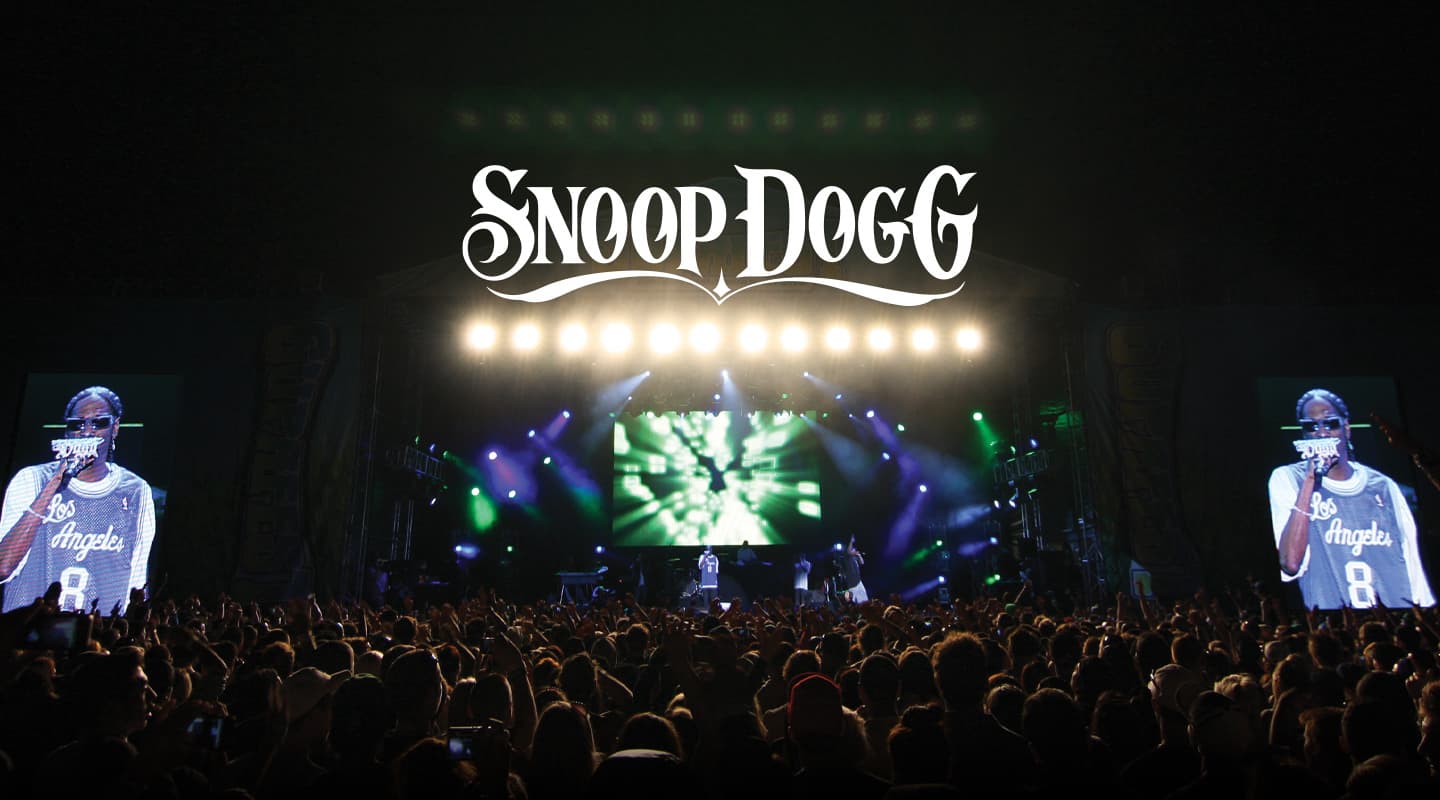
Snoop Dog & Dave Aron: Live at Supafest
At this year’s Supafest at the Melbourne Show Grounds, AT caught up with an engineer with a fascinating career, both live and in the studio.
I think I was the last person to walk through the gate at Supafest. By the time I rocked up the security guards at the front entrance were wandering aimlessly, head down, kicking small rocks along the gravel road, wishing they were anywhere else. There was garbage everywhere and nearly all the acts had come and gone.
I was still several hundred yards away from the main arena at this point but already I had a strong sense that this gig was going to be loud. Somewhere just over the rise all hell was cutting loose – someone was playing a 60-foot kick drum (or so it seemed) and the crowd was responding as one giant acoustic white noise generator measuring up around 100dB. Somehow I had to hook up with Dave Aron – Snoop Dogg’s front of house (and studio) engineer – in amongst all this madness. I pushed through the countless heaving, sweaty, tattooed, weight-trained and cleavaged bodies and screamed down the ear canal of one of the security blokes at front of house: “I’M LOOKING FOR DAVE ARON!” to which he first looked bemused, then thoughtful, then politely stood to one side without responding.
At front of house I quickly spotted a guy looking into the crowd in similar bemusement. ‘That must be Dave’ I thought. I took a chance… “Dave?”
“ANDY, HEY… THANKS FOR COMING MAN, NICE TO MEET YOU!” Dave yelled mercilessly down my right ear canal. “MAN THAT’S A CRAZY CROWD OUT THERE,” I yelled back, as I put all my crap down and heaved a sigh of relief.
From that point on my ears endured more punishment than a Welsh rugby scrum. Glancing around the mix position while Nelly played a bad AC/DC cover, I immediately spotted a glowing decibel speedo that was proudly measuring the gig at 119dB (C-weighted). “BLOODY HELL! IT’S LOUD!” I joked to Dave. “IS THE EPA GUY BOUND AND GAGGED IN THE TOILET OR SOMETHING?”
MIXED EMOTIONS
Dave Aron has been mixing live and in the studio since the early ’80s, engineering and mixing countless multi-platinum selling albums for artists such as U2, Price, Dr Dré, Bobby Brown, 2-Pac and the man of this particular hour, Snoop Dogg. Dave first hooked up with Snoop back in ’92 when he was only a pup. Dave had been working at the famous Larrabee Studios in LA with several other acts when the two did some recording sessions together and quickly hit it off. Since then Dave has worked on several of Snoop’s albums, and mixed hundreds of his live shows.
It’s still unusual to come across an engineer that’s been so successful in two disciplines. I knew Dave was a studio engineer at heart but he looked super relaxed at front of house, blasé even. After the show I asked him how he’d managed to become so comfortable with both roles:
Dave Aron: Actually, when I first hooked up with Snoop Dogg I thought the live side of my engineering life was over. I’d done a lot of live mixing when I was in college mainly because it was easier to do that than get a job in a big studio. I figured it had been fun and I’d loved the immediate gratification of live sound but I really liked the long lasting rewards of the recording industry too. I always like to hear stuff I’ve recorded or mixed on the radio, see my name in the credits, hold the album in my hand – like we all do – because when the concert’s over, it’s over.
But in 1995 when Snoop asked me to tour with him so that his gigs ‘could sound as good as his records’, I said ‘sure, we can work that out, go on the road’. Hey, it was Snoop Dogg – you don’t want to turn that gig down! It sounded fun, got me out of the studio and travelling around the world, seeing places I’d never been before. At that young age, circumnavigating the globe with Snoop was amazing.
And it’s still a lot of fun. Snoop and I have a very close working relationship these days. I ride with him to the gigs – I don’t ride the crew bus – I get well paid and I don’t have to share rooms with other people. That’s about as good as it gets on the road.
PARALLELS & DIFFERENCES
Andy Stewart: What are the parallels between your studio and FOH mixing work would you say?
DA: I have a studio mindset when I’m mixing live, meaning that I like to have the gig sound as it would in a studio through some decent monitors. I’m always trying to eliminate the ambience of the room or venue to make it seem as though I’m in a studio. Having said that, this doesn’t mean my technique is the same as if I was in the studio. It’s quite different even though the results are much the same. Live you’re dealing with open mics and a lot of other things you don’t have to contend with in the studio. For example, I do a lot of additive EQ when I’m in the studio, and use less compression, whereas live I tend to use more compression and subtractive EQ, and then turn the whole thing up.
AS: Why so?
DA: When you’re in the studio you’re trying to bring out the best of a lot of sounds whereas live, turning things up tends to reveal stuff I want to remove. Consequently, I’m usually ‘taking the garbage out’ with subtractive EQ, and then turning the sound up to compensate. Instead of increasing the high-mids and highs to make a sound cut through as I might do in the studio, live I’ll take out low-mids and lows.
Quite often there’s a lot of ugly low-mids coming off stage. To me a lot of that information almost hurts your ears live and clouds things in a gaudy way.
AS: By low-mids are you generally talking about frequencies below around 900Hz, or more like 600?
DA: I’m talking about say around 630 – 800Hz. Lower than that too sometimes; it depends on the room of course. I find a lot of problems at 400 and 500Hz too. So I suppose I’m talking about anywhere from 800Hz all the way down to about 160. I’m always ducking and sweeping the EQ so I can find exactly where the problem lies and what makes it sweeter when I dip it. For instance, with the kick drum I tend to take out anywhere between 400 and 600Hz – I’m just gonna pull that right on out. When I take those frequencies out I get a much more polished result.
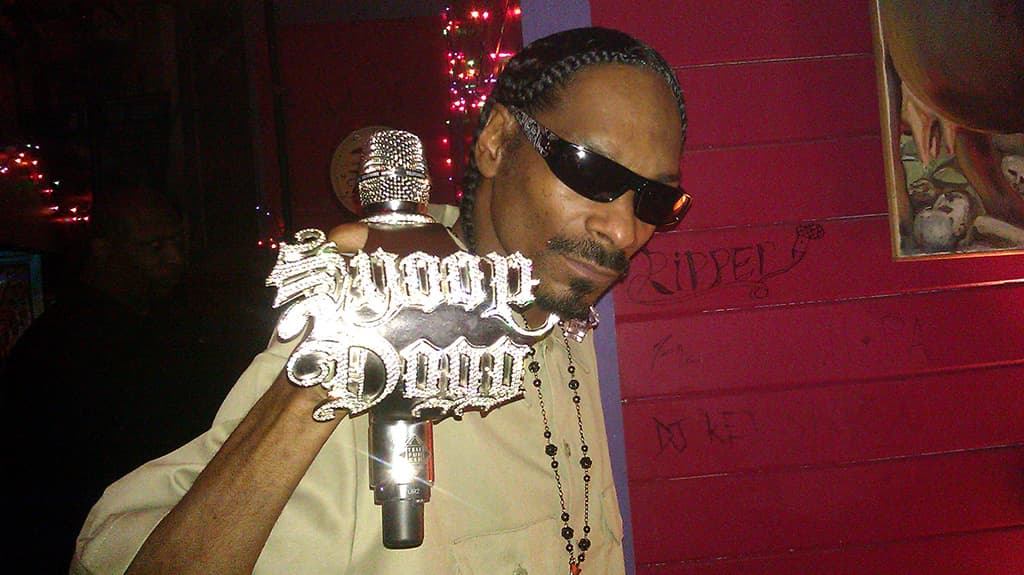
HIP-HOP SUBS
AS: Has hip-hop got an overall EQ, stylistically speaking, would you say?
DA: No, I don’t think so. Although I sometimes find these hip-hop gigs a little heavy in the subs department. At a rap gig like this, everyone seems to think it’s very important to have a ton of sub and consequently a lot of times the PA doesn’t have enough highs and mids to cater to the clarity I’m after. Often they think hip-hop has gotta have an overload of bass – and it’s true, it does – but it still has to be even all the way up to the top-end.
I hate hearing mixes where it’s just too subby. A lot of times I actually have to turn the subs down so that I can get more volume out of the PA. That generally gives the system back a lot of its clarity and headroom. You still get the bottom-end, just without the boominess.
I high-pass filter the low end of the PA up to maybe 40, 50 or even 60Hz sometimes. This allows me to turn the whole system up more and ironically get more bottom-end out of it. You might think you’d get more power leaving those super-low frequencies in but really it’s just adding more boom and garbage. It’s not as tight sounding either, and I like a tight low end. Basically, if you amplify 30Hz it’s not gonna do much of anything except eat up your amp power and all your speaker space.
AS: What instruments penetrate right down into the sub-harmonics of your mix after you’ve filtered the system like that? Just kick and bass?
DA: It depends. We do a lot of DJ gigs with Snoop, and others with the full band. If I’m doing a DJ gig I’m going to try and get as much out of that DJ system as I can. I will maybe filter up to 40 or 50Hz sometimes – depending on the song even. Some songs have so much bottom end in them that I have to filter them quite heavily. Because every record they’re spinning was mixed at a different studio, sometimes I find those gigs are more like a live mastering session. I know certain songs are going to need some high-end pulled out otherwise it’s going to sound really brittle but then the next song needs all that put back in.
SHEER VOLUME
Sitting backstage with Dave after the show – with post-concert festival mayhem all around us – I remarked on how loud the concert had seemed earlier in the night. I had to break out my in-ear monitors – sans cables – which do a good job of knocking the sound down to more modest levels, but at that point of the show it was pretty much all over in terms of fidelity…
DA: Ha! I thought that was about normal volume for us – a comfortable mixing level. I don’t like to go too much louder than that but I certainly don’t like it to get any quieter. If it’s less than that I’m usually dissatisfied.
AS: So 116dB (C-weighted) is normal for you?
DA: Pretty much. Don’t forget though that with the mix position elevated on a riser like it was tonight – and everybody else on the ground – you’re going to get much more clarity and subs. So in some ways that dB figure was slightly misleading. That’s why I kept stepping down into the crowd – to hear what it really sounded like at ground level.
I have to adjust what I’m hearing sometimes to cater to what the audience needs. There might be more bass at my mix position than I’d prefer but I have to tolerate that to give the audience the right mix. I find myself in that situation a lot!
NO DOGG’S BREAKFAST
AS: I was amazed how refined it sounded tonight I have to say – before I put the plugs in. Apologies! One of the best lives mixes I’ve ever heard. I guess, because it was a festival gig, I was expecting it to sound pretty chaotic up there. Was any of the music pre-recorded tonight?
DA: No, but I can sympathise with your expectations. As you infer, most rap shows I hear sound very chaotic and I don’t like that at all. They’re mostly all bass – really boomy with a bunch of guys yelling on stage. You never really hear the lead guy because there are so many others trying to fill the space. And sometimes the sound engineer doesn’t know the music and therefore who to turn up when they’re rapping. Snoop’s gigs on the other hand are very controlled, although a lot of credit for that must go to the band and Snoop Dogg himself.
AS: Yeah, they seem incredibly tight.
DA: Snoop is dominant and all the other guys know how to work their mics and be right under him – that’s why I think it sounds less chaotic. Add to that the fact that I remove some of the boominess from the PA and it amounts to a significant difference. Unlike some, I’m lucky in that I’ve actually got signals I can work with and mix properly!
REAL DRUMS
AS: And you had real drum sounds up there tonight I noticed. Were you triggering stuff as well to augment the real kit?
DA: We are triggering other sounds – the drummer has a pad up there that he plays a lot of claps and wind chimes sounds with. But the kick is all acoustic and the snare is all real snare. There aren’t any triggers adding to their tones. There are two mics on the bass drum that I often blend together: one gives me the attack and the other provides the thump and sustain. I also double-mic the snares – of which there’s often three.
AS: What mics are you using?
DA: We usually use an AKG D112 on the outside of the bass drum and a Shure Beta 91 – the flat boundary mic – in the bottom of the drum. I use the 112 a lot live because it’s got a nice attack to it and I’ve been using it since the ’80s, so you kinda get used to shit don’t you. I don’t rely on it 100 percent though, and I don’t always blend the two mics either. Sometimes I just end up using the one that sounds best on the night. Snares, I generally mic top and bottom, and in terms of the mix I might distinguish one snare from the others by adding a little more reverb.
SNOOP’S VOCAL
AS: What mic does Snoop sing into these days?
DA: Funny you should ask that because I only got a new mic for him three weeks ago. We used to use a blinged-out Sennheiser, which was cool, but that was starting to need replacing so we swapped if for this new Telefunken. It’s basically a Shure wireless mic with a Telefunken M80 capsule replacing the 58. I love it: it’s got a higher output and much greater fidelity. It’s still a dynamic mic but it has a lot of feedback rejection on the back end… it’s very directional.
AS: What’s Snoop’s voice like to work with?
DA: He’s got an awesome voice. He raps low but he knows how to push from the diaphragm and project his sound. He’s got a hell of an ‘s’ on him though. I usually haave to run a de-esser across it, which ideally is a dbx 902; that’s the king. You can’t beat it. Digitally, a lot of times Snoop’s signal chain will have an 1176 plug-in and an SSL channel strip to give it that pristine sound and then I’ll follow that up with a Waves C4 multiband compressor so I can smooth out any frequencies that threaten to get too strident.
With Snoop’s voice I generally go for a direct, in-your-face sound, so I don’t put a lot of reverb on him… or anything else for that matter. I like a very in-your-face sound. I always use echoes and reverbs sparingly – as you may have heard tonight – manually riding them in and out instead of leaving them static in the mix. It gives me the dry punch I need and the spacey contrast at specific points. That’s one of the differences with live mixing. You don’t need ambient reverbs of any kind in most venues.
DRIVING THE MIX-BUS
AS: What about overall mix-bus compression or EQ. Do you use any of that, and if so, what?
DA: I EQ and compress everything on the individual channels, so no, there’s nothing on the main bus. I don’t like compressors on the mix bus unless we’re in a club situation, but again it really just depends on the venue. I’m also constantly checking whether the system tech has things too compressed. If I can’t get any bottom end or volume out of the PA, or if I can hear the system breathing and pumping, I always say something – back it off or give it a faster release time. I’m big on releasing compression.
If I use any kind of bus compressor I find I’m usually mixing it back in with the uncompressed signals – that works for me sometimes. For instance I might slam a compressor with a bunch of drums, then mix that back in with the uncompressed signal, but I’m not gonna rely on that for my entire drum sound. It’s not what I’m looking for sonically. I can usually get the sound I want by treating individual channels.
I don’t put too much individual compression on Snoop’s vocal either, or much on the bass. But then again, sometimes I do. That’s the whole thing about this live gig. You can never say ‘I always do this’ or ‘I never do that’ because the day I say it, the next day I’m doing it, you know? There’s always something different happening at the next venue – that I do know! That’s half the fun of it.
I like the dynamics in our show. That’s one of its strengths and I don’t wanna choke it. As a general rule I find I’m usually loosening things up. Things sound too constrained to my ear when you have things too compressed. I don’t like that sound.
I like multiband compression a lot, maybe even more than regular compression because they’re reactive to tone not just overall gain, like the Waves C4. For instance, I like to boost a lot of presence into Snoop’s vocal but I don’t want it to sound shrill and harsh when he hits the mic hard, so I set up the C4 to catch those frequencies when they need controlling. And I have a disclosure to make here: I’m a Waves representative, so I do a lot of beta testing for them and use a lot of their plug-ins.
AS: So you’re really using the multi-bands to control the tone of the mix more than the dynamics in some respects, which is very much a studio mentality.
DA: Exactly. They catch the ugliness. That’s exactly what I like about multi-band compression.
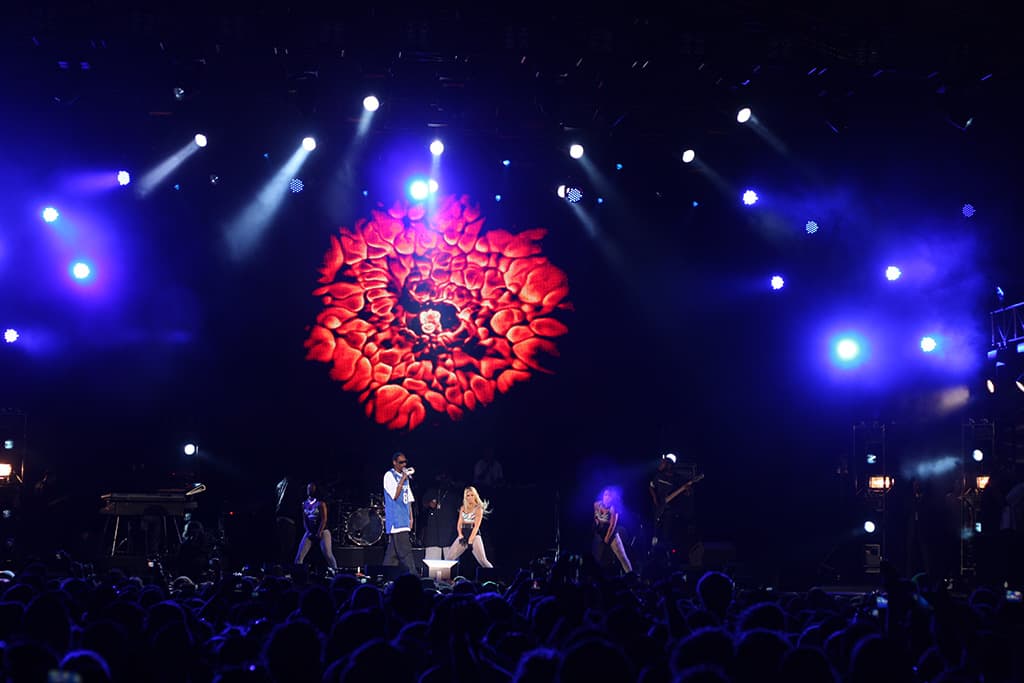
THE STUDIO MENTALITY
AS: Can you tell me a bit more about what taking a ‘studio mentality’ out on the road with you means in a practical sense?
DA: It means I’m used to being in the studio, making mixes sound exactly how I want them to and I like my live gigs to sound that way too. I like to hear every nuance in a live mix: every little thing that Snoop’s doing with his voice; the grace notes Carlos is playing on the snare; the little keyboard parts and the percussion stuff, which I’ll pan here and there. I want to hear a whole spectrum of sound coming at me, not just a bunch of instruments piled up in the centre sounding like a glorified line check. I find a lot of sound guys do that. They bring sounds up to where you can hear them, but that’s not really a mix is it?
I try and create a big picture with the sound. That to me is what I mean by a ‘studio mentality’. I’ve been in the studio so much that I can’t really hear music any other way. I don’t like to hear it and go, ‘oh that sounds live’. I don’t like that kind of comment at all. I want people to go away from these gigs going, ‘Oh fuck, it sounded like we were in my living room or the studio’. I want drummers from the audience to come up to me and say, ‘Wow, I loved the way you had the drums sounding tonight man, they were killer!’. I want guitarists to come up to me at the same gig and say, ‘Man those guitars sounded awesome tonight’. That’s what I’m going for. I hate the attitude that says, ‘Well it’s a live gig, it’s alright if it has this or that shortcoming’. I want to appeal to every person in the audience, not give them one type of generic sound.
I’m always tweaking the mix until it comes alive – that’s the point where it suddenly becomes studio quality.
AS: Is most of this tweaking essentially about EQ once the gig’s in full swing?
DA: A lot of it is EQ; a lot of it is balancing the gain structure. I try to keep my faders at nominal levels as much as I can and deal with the ‘head amps’ – as they’re called nowadays – to balance things out. But likewise I’m more than happy to have the keyboards down at –20 if necessary. I’m not scared to move a fader! The thing is I need a lot of headroom because I hate running everything hot. I like everything to be cruising. I’m always telling system engineers to ‘open it up please’, and then let me bring it back down to a manageable level where I can control it.
I like a system that’s got a ton of headroom where elements are discrete and distinct. To me it’s the equivalent of a racing driver in a Formula One car. You’ve got to be skilled to drive it when it’s that powerful and wide open, but if you’re good you’re gonna win the race. It’s the same with a great engineer on a great system. The opposite is also true: put a great driver who’s used to a Ferrari in a little Honda and you’ll have the thing redlining all night. You’re never really gonna win that way. If you’ve got plenty of power and headroom, and the smarts to control the PA without applying mountains of crude compression, you’re the winner.
AS: What about panning?
DA: I do pan a lot but it really depends on the venue. When I’m at The House of Blues in L.A. for instance I have stuff panned all over the place like an album. But with DJ-based Snoop gigs I find I only get enough punch out of the system if it’s panned at around nine and three o’clock, or sometimes even ten and two. It also just depends on how I’m feeling on the night. Sometimes I’ll do an audiophile mix, sometimes I’ll do a more in-your-face, kick-ass, raw, hard mix. It really depends on the venue and whether there’s a dB restriction – things like that.
If you have a ridiculously low decibel restriction – and they’re very strict about it – that’s when I’ll typically pull out a real audiophile mix, where I have things panned all over the place, and more bottom-end to make it feel like you’re sitting in your living room listening to a record.
SPEAKER POSITION
AS: You’re big on speaker placement I understand.
DA: … and I always say this about it: a good live mix is all about the speaker position. If you’ve got that right you’ve got 90% of the game won. If the speakers aren’t positioned properly – if I walk in and see a stacked PA, right away I’m like, ‘oh boy, this might be a problem’. Shit, give me a Peavey board, I don’t care. It’s not going to make my mix – it’s just not. The other thing that’s critically important is you want to have good amps, and enough power.
That’s the whole game to me. Forget about the compression, forget about the board, if I have a set of correctly flown speakers and some kick-ass amps I could do a whole gig with no reverbs, no effects, no compression and a cheap-arsed board. The rest of this shit is really kind of incidental, a luxury at that point.

WHEN TO TURN UP
AS: So do you go to all your gigs early then and get involved in setups or are you mostly reliant on system techs?
DA: I rely a lot on system techs… and a lot on just chance!
AS: So you’re not rocking up 12 noon going, ‘Hey that’s not right, you gotta change that?’
DA: No, because, as I said earlier, I’ve got a real comfortable position here where I ride in Snoop’s bus and it’s fun. We play video games the whole way – it’s a laugh a minute. Snoop leaves a lot later than the crew you see, so sometimes I don’t even make it to soundcheck.
AS: Seriously?
DA: Yep. If I get there beforehand then cool, that’s a bonus. But I always know I’ve got the first song to get it together and I mostly trust the system techs to get it right. I really don’t have time to go in at noon and sit there all day and play with the system. I don’t like long sound checks anyway, and besides, it never comes out sounding the same as when you left it at soundcheck anyway. Once the venue fills up with bodies it’s always different. There’s all this noise in the room for starters. You always think you’ve got it loud enough… but it never is! People are making so much noise that the clarity is almost halved from what you had at soundcheck. There’s no 90dB noise floor to overcome so what’s the point? I like to be prepared for the gig but I don’t rely on soundcheck to be everything it’s going to be that night. A lot of this game is about making it happen on the night, staying relaxed and sticking with it.
If I were doing monitors I certainly couldn’t operate like that – no way. There’s far too much preparation. But at front of house I’ve only got one mix to deal with and I know what my priorities are. As soon as the show starts I know it’s gonna start with some sort of DJ intro and I’m gonna have that up. And then the DJ’s gonna talk so I know I gotta have his mic up. I know Snoop’s gonna come out next and I make sure his voice is heard as soon as he says his first words.
AS: How do you determine that for sure?
DA: Well I hear him saying little things before the actual verse comes in. If he doesn’t say anything then my heart always skips a couple of beats hoping it’s gonna be there. But once I hear him saying some hype stuff like, ‘Hey what’s up everybody?’, I know it’s gonna be right. Once that’s established, I’m all good. Then I start working on other stuff.
I’ll go right away to the kick, make sure I can hear that nice and solid. Make sure I can hear the snare hitting right where I want it. Next I make sure the bass is filling in everything. Then the keys – they’re gonna be there – they always are! And that’s pretty much the essence of the whole mix. By the second song I’m just tweaking.
AS: Do you have song presets on the digital consoles at all?
DA: No, never. Usually we don’t get the same board two nights in a row. Hell, usually I never even know what board I’m gonna be looking at until I get there. It could be a Yamaha PDM5, it could be Digidesign Profile… whatever. The other night I walked in and discovered a Midas Pro 6. I was stoked! It was the first time I’d worked on one of those – it was awesome. It sounded so good – heavy duty. That’s a great board!
One board I’ve really been liking lately is the Soundcraft Vi6. Those are nice. I really like their sound. The new Digicos are nice too. But as I say, I never know what I’m gonna get that night. So as you can imagine it’s hard to have presets when you don’t even know what board you’re gonna be using! I just dial up the mix and it is what it is.
AS: That’s a pretty refreshing – almost anarchic – perspective, I’ve gotta say.
DA: Well it is. For me it works. A lot of guys are really anal and obsess over preparations, but that’s just not me, you know? I don’t say they’re wrong for working the way they do. There’s a guy who mixes for Tool, who I met at a gig, who showed up at eight in the morning and worked with the system techs all day. He had the whole thing sounding really nice and he was there till the end of the night! That’s dedication. By showtime it sounded awesome! I can appreciate that whole approach; it’s just not for me that’s all. I’m an on-the-fly kinda guy.
AS: I guess it’s good to know your strengths. There’s no point trying to be ‘anal guy’ when you’re just not.
DA: Exactly. In truth, I’m trying to get in and out of soundcheck as fast as possible, I’m not gonna lie to you! I never leave before I feel it’s ready but once it is I’m outta there! I know I’m gonna be able to fix whatever I need to fix that night so there’s just no point hangin’ around. That approach comes back and bites you occasionally, I’ll admit, but most of the time it’s cool. And it makes the gig exciting for me. I need that little extra juice, that bolt of adrenalin.


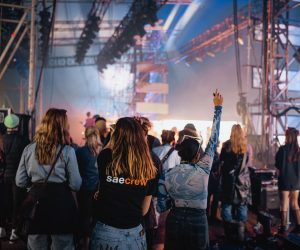

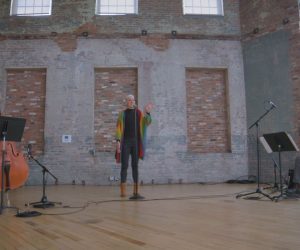


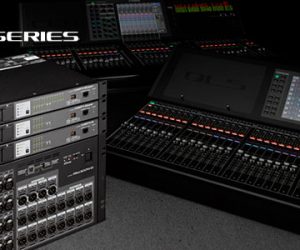

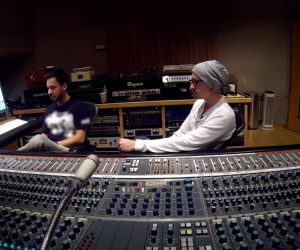





RESPONSES